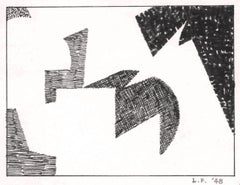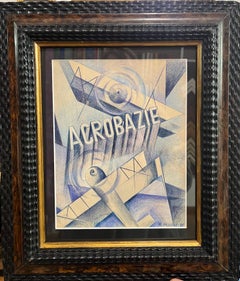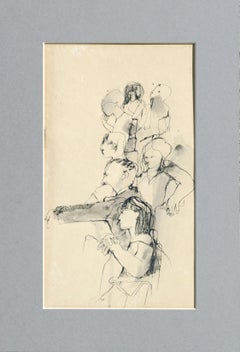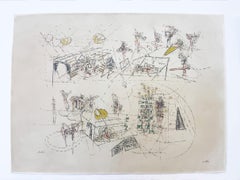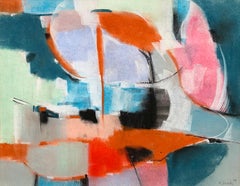20th Century Abstract Drawings and Watercolors
Abstract Expressionist 20th Century Abstract Drawings and Watercolors
Paper, Ink
Futurist 20th Century Abstract Drawings and Watercolors
Crayon
Abstract 20th Century Abstract Drawings and Watercolors
Oil Pastel
American Modern 20th Century Abstract Drawings and Watercolors
Paper, Pen, Watercolor
20th Century Abstract Drawings and Watercolors
Paper
Abstract Expressionist 20th Century Abstract Drawings and Watercolors
Pastel
Abstract Geometric 20th Century Abstract Drawings and Watercolors
Paper, Pastel
Contemporary 20th Century Abstract Drawings and Watercolors
Paper, Pencil
Abstract Impressionist 20th Century Abstract Drawings and Watercolors
Paper, Charcoal
American Modern 20th Century Abstract Drawings and Watercolors
Paper, Ink, Gouache
Abstract 20th Century Abstract Drawings and Watercolors
Paper, Gouache
Abstract Expressionist 20th Century Abstract Drawings and Watercolors
Watercolor, Tissue Paper
Abstract Expressionist 20th Century Abstract Drawings and Watercolors
Ink, Gouache, Screen, Graphite
Minimalist 20th Century Abstract Drawings and Watercolors
Permanent Marker, Offset, Postcard, Lithograph
Abstract Expressionist 20th Century Abstract Drawings and Watercolors
Paper, Charcoal, Graphite
Abstract Expressionist 20th Century Abstract Drawings and Watercolors
Paper, Watercolor
Abstract 20th Century Abstract Drawings and Watercolors
Watercolor
Abstract 20th Century Abstract Drawings and Watercolors
Graphite
Post-War 20th Century Abstract Drawings and Watercolors
Archival Paper, Pencil
Fauvist 20th Century Abstract Drawings and Watercolors
Watercolor, Paper
Abstract Geometric 20th Century Abstract Drawings and Watercolors
Paper, Watercolor, Pen, Pencil
Contemporary 20th Century Abstract Drawings and Watercolors
Paper, Pastel
American Realist 20th Century Abstract Drawings and Watercolors
Lithograph, Acrylic, Paper, Pencil, Ink
Abstract 20th Century Abstract Drawings and Watercolors
Pastel
Abstract 20th Century Abstract Drawings and Watercolors
Pastel
Abstract Geometric 20th Century Abstract Drawings and Watercolors
Paper, Encaustic
American Modern 20th Century Abstract Drawings and Watercolors
Pastel
Abstract Expressionist 20th Century Abstract Drawings and Watercolors
Paper, Watercolor
Abstract 20th Century Abstract Drawings and Watercolors
Paper, Gouache
Abstract Geometric 20th Century Abstract Drawings and Watercolors
Paper, Oil
Abstract 20th Century Abstract Drawings and Watercolors
Paper, Gouache
Abstract Geometric 20th Century Abstract Drawings and Watercolors
Charcoal, Pastel, Mixed Media
Abstract Geometric 20th Century Abstract Drawings and Watercolors
Paper, Pastel
Abstract 20th Century Abstract Drawings and Watercolors
Paper, Gouache
Abstract 20th Century Abstract Drawings and Watercolors
Paper, Gouache
Abstract 20th Century Abstract Drawings and Watercolors
Paper, Charcoal, Pastel
Abstract 20th Century Abstract Drawings and Watercolors
Paper, Oil Pastel, Gouache
Modern 20th Century Abstract Drawings and Watercolors
Etching
Abstract Geometric 20th Century Abstract Drawings and Watercolors
Acrylic, Watercolor
Abstract Impressionist 20th Century Abstract Drawings and Watercolors
Paper, Ink, Gouache, Lithograph
Abstract 20th Century Abstract Drawings and Watercolors
Paper, Gouache
Abstract 20th Century Abstract Drawings and Watercolors
Paper, Mixed Media, Acrylic
Modern 20th Century Abstract Drawings and Watercolors
Paper, Ink, Pencil
Abstract 20th Century Abstract Drawings and Watercolors
Oil Pastel
American Modern 20th Century Abstract Drawings and Watercolors
Ink, Gouache, Graphite
American Modern 20th Century Abstract Drawings and Watercolors
Paper, Oil Pastel, Gouache
Abstract 20th Century Abstract Drawings and Watercolors
Paper, Gouache
American Modern 20th Century Abstract Drawings and Watercolors
Ink, Gouache, Graphite
Abstract 20th Century Abstract Drawings and Watercolors
Pastel, Handmade Paper
Realist 20th Century Abstract Drawings and Watercolors
Watercolor
Constructivist 20th Century Abstract Drawings and Watercolors
India Ink, Watercolor
Surrealist 20th Century Abstract Drawings and Watercolors
Color Pencil
Abstract 20th Century Abstract Drawings and Watercolors
Paper, Watercolor
Surrealist 20th Century Abstract Drawings and Watercolors
Paper, Gouache
Futurist 20th Century Abstract Drawings and Watercolors
Paper
American Modern 20th Century Abstract Drawings and Watercolors
Paper, Watercolor, Pencil
Abstract Impressionist 20th Century Abstract Drawings and Watercolors
Paper, Watercolor
Abstract Expressionist 20th Century Abstract Drawings and Watercolors
Paper, Watercolor
